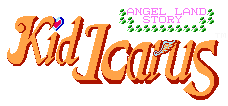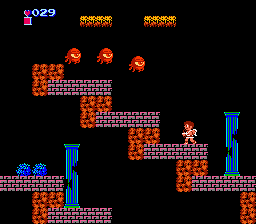 ... ...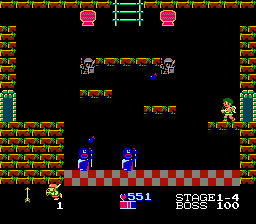
The mid-1980's was a time when video games were being pushed out of the one-screen arcade era and into a new age of epic sidescrollers and adventure games. As a game of that transitional era, Kid Icarus feels as much an experiment in the technological advances that made it possible as it does a merger of ideas that would continue propelling the media into new generations and beyond. Adventure elements, such as stat-building and maze exploration, stitched into the framework of an intense action game, made Kid Icarus offbeat and stand out. Unlike Super Mario Bros., the forefather of the sidescrolling platform genre, Kid Icarus boasted both horizontal and vertically-scrolling stages.
And yet, it remained one of gaming's biggest oddities for many years. It was never a huge smash hit like Nintendo's other major titles, Super Mario Bros., The Legend of Zelda, and Metroid. It was popular enough that the main character, Pit, and the enemy character, Eggplant Wizard, were featured in Nintendo's Saturday morning cartoon show, Captain N: The Game Master (this being the only way some people were even familiar with Kid Icarus at all.) But the game dropped off the radar, and the only peep out of the series for years was a 1991 Game Boy sequel that is questionably canon at best.
 ... ...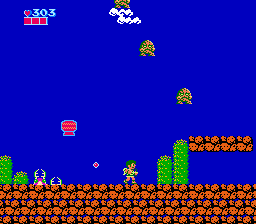
Somehow, some way, Kid Icarus has retained a cult following that is fueled in part by the game's quality design, and perhaps also (maybe moreso) by its uniqueness. Though it borrows from Greek and Roman mythology for its central theme, the developers weren't content to leave it at that. Yes, we have your multi-headed underworld dog, your dragons and Centurions, harpies, Medusa, and a Greek column or two. But they play second fiddle to the flying Groucho Marx noses, disembodied Mick Jagger lips, screaming Grim Reapers, and cyclopian eggplants that, with a shot from their wands, can turn Pit into a functionless squash. This is a game that begged to be remembered.
The premise is no less bizarre. The story begins with the Goddess Palutena being imprisoned in her own Sky Palace by the Goddess Medusa after they got into a spat that culminated with Palutena turning Medusa into a monster (probably not the smartest move in the world, but those gods can be a haughty lot). Pit, a small flightless angel and captain of Palutena's personal army (!), escapes from an underworld prison and begins an epic voyage across Angel Land to find three "Sacred Treasures" that will grant him the ability to storm the Sky Palace and evict Medusa.
 ... ...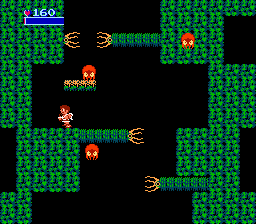
The odds are certainly not in Pit's favor, as he can take few hits at the onset of his journey and the range of his bow and arrow is severely limited. The irony of being a flightless angel in a place called "Angel Land" means that a good 65% or more of your adventure takes place over a huge gaping bottomless void. Imagine some of the most heinous kinds of jumps in existence - across tiny platforms, moving platforms, icy platforms, and platforms spaced so far apart that you can only just barely make it. Now imagine that all the while there is absolutely *nothing* underneath to catch you if you should fall. That's what the greater portion of Kid Icarus is like.
The stages are long and grueling. No matter how close to the end you are, one slip-up could spell disaster. And if that doesn't get you, succumbing to the neverending enemy onslaught could. Pit does not get extra lives - a lost life is an instant "Game Over". Angel Land is a cold, cruel environment, indeed, but there is some help along the way in the form of shops and gods that grant weapon and life powerups.
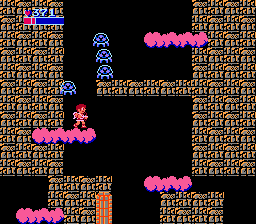 ... ...
Kid Icarus is infamous for a design flaw that (supposedly) places the hardest parts in the first three levels, while the rest is significantly easier. There is a bit of truth to this, but it isn't the whole story. The main reason the game is hardest at the beginning is because of Pit's short life meter, which will increase as you complete stages and achieve higher scores. However, even before such upgrades are bestowed, plenty of chances to replenish Pit's hit points are offered, such as healing potions that can either be bought at stores or found for free. The game is not big on rewarding those who attempt to rush through it - planning, taking things one step at a time, and a few practice runs are encouraged if not required.
A secondary reason Kid Icarus becomes easier is from acclimation to the controls. A fall from a platform in World 3 is just as likely to end your game as a fall in World 1, but by the time you reach World 3, you should be much more used to the jumping control and less likely to make mistakes.
Overall, there are three noticeable difficulty spikes: The first is World 1-3, where Pit's short life meter and an abundance of damage zones will be his biggest hinderances. The second is World 2-3, the last of three horizontally-scrolling stages, which is exceptionally long and unforgiving. The third is World 3-4, the largest and most confounding of the maze-like fortresses, which features a meticulously placed pair of Eggplant Wizards that can force many a do-over. Drawing a map might be essential for success there.
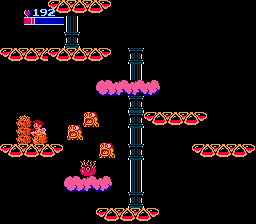 ... ...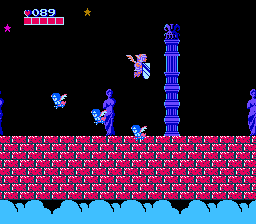
The final stage breaks form by forcing Pit into an autoscrolling shoot-em-up stage. (This is the result of equipping the three Sacred Treasures - Pit gains the ability to fly and an arrow that traverses the entire screen like a laser beam.) While this is a novel idea, it is unfortunate that this stage is the easiest in the game. Even if you manage to reach it somewhat underpowered, the enemy patterns aren't tough to handle and the final boss can be beaten without taking a hit. But it's easy to forgive this when the game has already delivered so many thrills before this point.
Kid Icarus's minimalist graphic style heavily resembles Nintendo's earlier NES hit, Metroid. Both were designed by the late Gunpei Yokoi and worked on by the same development team. Presumably both games utilized the same engine, and Kid Icarus's "Komayto" enemies are based on the eponymous Metroid foes. The result of these similarities is a world that is not quite the happy, cheerful setting a name like "Angel Land" might evoke. It is dark, dreary, maybe even a little depressing, and includes two moments of "what the heck?" for anyone familiar with Nintendo of America's strict censorship rules of the era: a graveyard full of tombstones adorned with crosses in World 2-3, and topless Venus de Milo statues in the final stage.
 ... ...
The ambitious soundtrack, renowned as some of composer Hirokazu "Hip" Tanaka's finest work, perfectly complements the setting and tone. It's generally driven by a grandiose march style, as heard in the title, ending, first stage, and last stage themes, but segues into a more haunting and melodic tone for the eerie fortresses. The rest is rounded out nicely with a couple of lighthearted tunes and creepy boss themes.
Along with Metroid, Kid Icarus is one of the first games to feature what is nowadays called a "New Game +", in which you restart from the beginning, but retain some of the stats you've built up from the previous play. This is what made it possible to get alternate endings in both games and is a good method of prolonging interest.
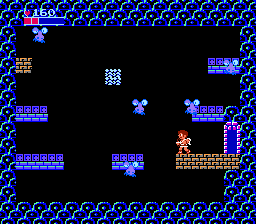 ... ...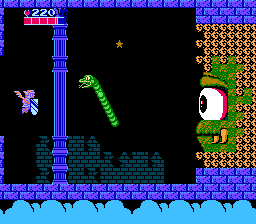
Kid Icarus teeters on the boundary between what games were and what they would strive to be - more epic in scope, more dynamic, more cinematic, more complete. It seamlessly combines its various modes of play, so that it never feels like a bunch of mini-games thrown together, but rather a game that presents its core control in new situations to keep players guessing at what will come next. If you like platform games at all, it is hard to imagine not liking Kid Icarus. If you're one of those who have never made it past Level 1, give it another try. Once you're over that hurdle, the world suddenly becomes a bigger place.
OVERALL
SCORE: 3.5/5
BACK
TO NES REVIEWS
BACK
TO MAIN PAGE
VISIT MY KID ICARUS SHRINE
|
